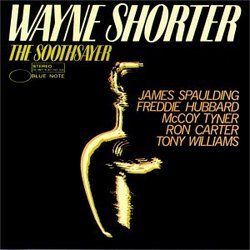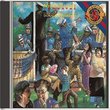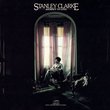| All Artists: Wayne Shorter Title: Soothsayer Members Wishing: 2 Total Copies: 0 Label: Blue Note Records Release Date: 4/4/1990 Genres: Jazz, Pop Styles: Modern Postbebop, Bebop Number of Discs: 1 SwapaCD Credits: 1 UPCs: 077778444329, 0077778444350, 077778444350 |
Search - Wayne Shorter :: Soothsayer
 | Wayne Shorter Soothsayer Genres: Jazz, Pop
|
Larger Image |
CD DetailsSimilarly Requested CDs
|
CD ReviewsNot one of Wayne's best Douglas Gray | Rochester, NY | 03/18/2000 (4 out of 5 stars) "This session, like Wayne's 'Speak No Evil" (1964), which introduced Herbie Hancock to Elvin Jones, brings together for their only collaboration of the next twelve years, the distinct powers of McCoy Tyner (piano) and Tony Williams (drums). The rarity of these collaborations make each of these sessions important historical events.Originally recorded in March 1965, the LP was first released in 1979 (according to the notes on my LP). It was recorded between Wayne's original releases 'Speak No Evil' and 'The All Seeing Eye', and just prior to 'Etcetera', first released in 1980.Besides Wayne Shorter (tenor sax) and the first meeting of McCoy Tyner (piano) and Tony Williams (drums), this date includes the ever-popular Blue Note frontmen Freddie Hubbard (trumpet) and James Spaulding (alto sax) along with Wayne and Tony's current associate in Miles Davis' quintet, Ron Carter (bass). With the exception of Wayne's arrangement of Jean Sibelius' 'Valse Triste', all of the works are Shorter compositions.The recording quality is average at best. McCoy's sound was less than brilliant; Ron a bit muffled, and Wayne sounded almost alto-like at times. (Uh, Note: I'm reviewing the LP - I don't own the CD for this one. The CD may sound better, but I've heard it doesn't. Also missing from my LP is an alternate take of 'Angola'.)Lost - Another in a long series of Wayne compositions in his popular, yet subtly executed triple meter, this work features the haunting and rich harmonies which Wayne can only express in this relatively rare sextet arrangement. Wayne takes the lead and delivers a soulful, yet subdued solo. Freddie follows with a very creative display, and James squeezes out the most thoughtful of the three. McCoy finishes rather quietly.Angola - An up-tempo swing number with a nice head. Sporting an uncharacteristically bright tone, Wayne goes first, and struggles until he finally finds a groove in time to conclude his solo. Freddie's follow is sharp, but James shines again in this number. Tony fires off a very inventive chorus alone, then out.The Big Push - Both rhythmically and harmonically rich, this Wayne composition implies a 4/4/3/5 meter feel during the melody, then straightens out into a comfortable 4/4 for the solos. Wayne is first again, and pours it on the floor with one of his most well-constructed and soulful improvs of the album. Freddie follows, and this time gets caught up in some of his increasingly popular antics, resulting in a less memorable display. James is firmly stitched in his groove once again, and digs deep. McCoy struggles telling his story, and is saved by the reemergence of the head.The Soothsayer - Another up-tempo Wayne original featuring an infectious and harmonic top-end. James starts things off with one of his slightly-outside, gut-wrenching displays. Freddie breaks up some otherwise crisp lines with more of his high-note antics, and Wayne follows with a powerfully expressive and energetic solo, all firmly supported by some of the best rhythm section work of the session. Ron and Tony continue to provide inspiring support to McCoy, who bangs out his best solo effort of the session, until running a bit dry at the end.Lady Day - True to form, this date also includes a Wayne ballad - this one in a slow, 4/4 meter - and dedicated to the great Billie Holiday. Wayne takes the head alone, displaying a smooth, hard, linoleum-like sound, compared to his more characteristic soft, velvety sound found on other ballad works of the era. McCoy is straight, yet pretty as the lead-off man. As the head reemerges, Wayne has company this time, as Freddie and James back him up with some nice harmony work.Valse Triste - Ever-so-loosely quoting the lines of Finnish composer Jean Sibelius, this triple meter piece starts off in a swing feel until Tony brings it around to a rare straight three feel. Wayne solos uncomfortably, and is shown up by James' more purposeful display. Freddie invents some real nice lines, until Tony changes it back to a swing feel, at which time Freddie falls off. Ron finally gets a chance to solo, and does so in characteristic fashion.This is a very good jazz album, but not a great one for Wayne. There's really nothing wrong with it - it simply lacks that important "something extra" we've become to expect from one of the most respected composer/improvisors of the era. Unfortunately, that historically significant pairing of McCoy and Tony did not prove to be musically significant, as they did not appear particularly collaborative, except on the title track. Ron played well throughout, but was not outstanding. Wayne and James take the highest honors for the session, which resulted in some fabulous saxophone work. After awarding 5 stars to most of Wayne's other Blue notes of the mid-sixties, I can't place this one on the top shelf with the others, so this one has to settle for 4 stars.Unless you already own them, I recommend investing in 'JuJu', 'Speak No Evil', 'Night Dreamer', 'Adam's Apple' or 'Etcetera' before this one." Mid 1960's Magic! 10/19/2002 (5 out of 5 stars) "When I first heard the title cut of this album in a record store over 20 years ago, I was fascinated by the sound of the group. Before I knew who was playing, I recognized McCoy Tyner and Tony Williams. But I'd never heard that combination before! The saxophonist sounded very familiar, but I couldn't figure out who it was. He sounded Coltranesque at times; at other times he reminded me of Sonny Rollins. His influences notwithstanding, he had a very unique sound and approach.Then I read the liner notes. Of course, Wayne Shorter! This was an incredible band: Wayne Shorter, James Spaulding, Freddie Hubbard, Ron Carter, McCoy Tyner and Tony Williams. The other players in this rhythm section elicited a nuance from McCoy's playing with which I was not familiar. James Spaulding and Freddie Hubbard are equally inspired. I've always admired the playing of James Spaulding, a shamefully underrecorded artist. Spaulding plays with an inspired elan that makes you wonder: Why only the handful of recordings under his own leadership?The title cut, "The Soothsayer," is a wonderful example of master soloists passing the baton throughout an inspired performance. Shorter's solo is a masterful lesson in how to tell a story. You can feel Ron Carter and Tony Williams right there with him as he builds tension leading to that split toned climax near the end of his solo.To my ears, Wayne's arranging throughout this album hints at the influence of Duke Ellington, via Charles Mingus, especially in the beautiful ballad, Lady Day. I would love to hear Wayne Shorter do more arranging for larger groups.I can't say enough about Tony Williams' drumming throughout this session. It is a reminder of how much he is missed. Only 19 at the time of this recording, he plays with such incredible technique, but is so musical. He was a master conversationalist. On this album, especially on the title cut, it is amazing how he could build such tension and release just by laying off his ride cymbal for a few beats.As the previous reviewer indicated, this is a "must have" recording for any Wayne Shorter fan. In fact, it is a "must have" for anyone who enjoys great music." Beautiful.... but problematic Douglas Gray | 08/23/1999 (3 out of 5 stars) "I have two reactions to this album. One is to recommend it highly: it has some of Wayne Shorter's chewiest and prettiest compositions--try "Angola" or "Lost"--and a knockout lineup: Tony Williams' drumming in particular is a joy. But there's one real problem here: the recording was badly botched (probably explaining why such an otherwise fine album was only released in the 1970s after Shorter had left Blue Note), and you'll note distortion on all tracks when the soloists or ensembles "peak" in volume. Unless you can mentally edit out the annoying buzz that results, you're better off trying other Shorter Blue Note discs. I'm willing to ignore this problem & concentrate on the music, as will other Shorter aficionados, but the casual listener will be put off."
|

 Track Listings (7) - Disc #1
Track Listings (7) - Disc #1


